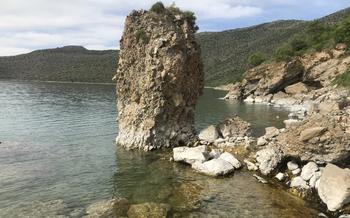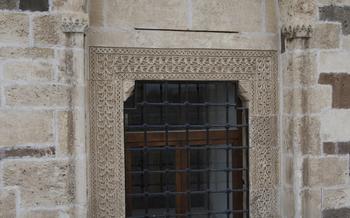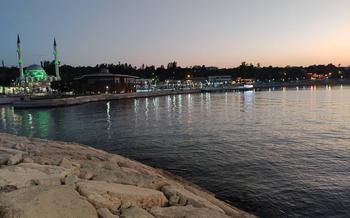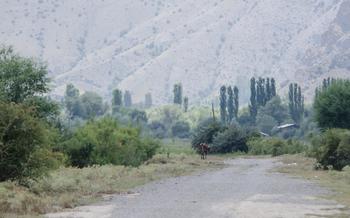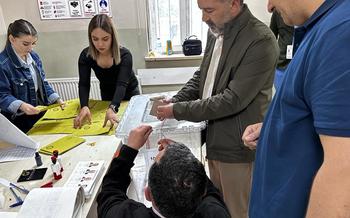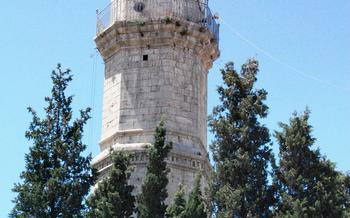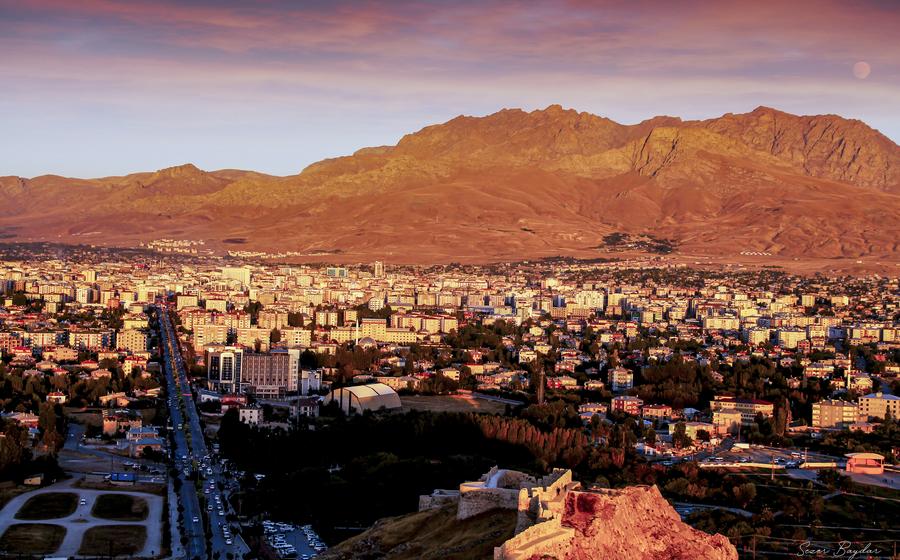
Kaya Celebi Mosque and Medrese
- The Kaya Celebi Mosque and Medrese: A Historical and Architectural Gem
- Location and Accessibility
- Visitor Information
- Exploring the Mosque
- Discovering the Medrese
- Historical Context and Legacy
- Anecdote: A Serendipitous Encounter
- Local Culture and Traditions
- Practical Tips for Visitors
- Panorama and Views
- Local Cuisine and Restaurants
- Shopping and Handicrafts
- Accommodation Options
- Nightlife and Entertainment
- Insider Tip: Unveiling the Hidden Treasure of Van
The Kaya Celebi Mosque and Medrese: A Historical and Architectural Gem
The Kaya Celebi Mosque and Medrese, nestled in the heart of Van, Turkey, stand as a testament to the city's rich history and architectural heritage. Built in the 13th century during the reign of the Seljuk dynasty, this iconic complex has played a pivotal role in the religious and educational landscape of Van for centuries.
The mosque, with its intricate tilework and graceful arches, exemplifies the Seljuk architectural style. Its interior is adorned with stunning calligraphy and verses from the Quran, creating a serene and contemplative atmosphere. The qibla wall, facing Mecca, features an ornate mihrab, a niche that indicates the direction of prayer.
Adjacent to the mosque lies the medrese, a religious school where students studied Islamic law, theology, and other subjects. The medrese's layout comprises classrooms, living quarters, and a library, reflecting its role as a center of learning and scholarship. Its collection of manuscripts, some dating back centuries, holds invaluable knowledge and insights into the intellectual and spiritual traditions of the region.
Location and Accessibility
The Kaya Celebi Mosque and Medrese are located in the heart of the historic city of Van, in eastern Turkey. The complex is situated in the Cavusbey neighborhood, a vibrant and culturally rich area known for its historical landmarks and traditional architecture. Getting to the mosque and medrese is relatively easy, as it is well-connected by public transportation. Visitors can take a local bus or minibus to the Cavusbey stop and walk a short distance to reach the complex. Alternatively, a leisurely stroll from the city center takes approximately 15-20 minutes, allowing visitors to explore the charming streets and admire the surrounding architecture.
Nearby attractions include the Van Fortress, a majestic citadel with stunning views of the city and Lake Van, and the Van Museum, which houses a collection of archaeological artifacts and historical exhibits showcasing the region's rich cultural heritage. Parking options are limited in the immediate vicinity of the mosque, but visitors can find public parking lots within walking distance. It is advisable to plan your visit accordingly, especially during peak tourist season, to avoid any inconvenience.
Visitor Information
The Kaya Celebi Mosque and Medrese are open to the public daily, except for during prayer times. Visitors are welcome to explore the complex independently or join a guided tour.
Entrance Fees and Discounts
Admission to the mosque and medrese is free of charge. However, donations are gratefully accepted to support the upkeep and maintenance of these historic buildings. Students, seniors, and groups may be eligible for discounts, so be sure to inquire at the entrance.
Opening Hours and Days of the Week
The mosque and medrese are open to visitors every day of the week, except for Mondays. During the summer months (April to October), the hours are from 8:00 am to 8:00 pm. In the winter months (November to March), the hours are from 9:00 am to 5:00 pm.
Guided Tours and Audio Guides
Guided tours of the complex are available in several languages upon request. Tours typically last for about an hour and provide visitors with a comprehensive overview of the history, architecture, and significance of the mosque and medrese. Audio guides are also available for rent, allowing visitors to explore the complex at their own pace.
Facilities for Tourists
The Kaya Celebi Mosque and Medrese are well-equipped to accommodate tourists. Restrooms are available for visitors' convenience, and there is a small cafe offering refreshments and light snacks.
Exploring the Mosque
Step inside the Kaya Celebi Mosque and be captivated by its awe-inspiring interior. The walls are adorned with intricate calligraphy and tilework, narrating stories from the Quran and the life of Prophet Muhammad. The mihrab, the niche indicating the direction of Mecca, is a masterpiece of Islamic craftsmanship, featuring delicate carvings and colorful tiles. The minbar, the pulpit from which the imam delivers sermons, is an exquisite piece of woodwork, showcasing the skills of local artisans.
The qibla wall, the wall facing Mecca, is a focal point of the mosque. It is adorned with elaborate decorations and verses from the Quran, guiding the faithful towards the direction of prayer. The chandeliers, suspended from the high ceiling, cast a warm glow, illuminating the serene atmosphere within.
Ascend the spiral staircase to the minaret, the slender tower that rises above the mosque. From this vantage point, you'll be rewarded with breathtaking panoramic views of Van and its surroundings. The cityscape, with its historic buildings and modern skyscrapers, stretches out before you, while the majestic Mount Suphan looms in the distance.
Discovering the Medrese
The medrese, adjacent to the mosque, was an integral part of the Kaya Celebi complex. Its layout mirrored that of many other medreses in the Ottoman Empire. A central courtyard, open to the sky, was surrounded by a covered arcade. Off the arcade were the classrooms, where students gathered to receive instruction from their teachers. The living quarters for the students and teachers were also located around the courtyard.
One of the most important features of the medrese was its library. The library housed a collection of manuscripts covering a wide range of subjects, including Islamic law, theology, philosophy, and science. The library was a valuable resource for students and scholars alike.
The teaching methods employed at the medrese were based on the traditional Islamic educational system. Students learned by listening to lectures, memorizing texts, and participating in debates. The curriculum was designed to provide students with a comprehensive education in Islamic studies.
The Kaya Celebi Medrese produced many distinguished scholars and religious leaders. These scholars played a vital role in the development of Islamic thought and culture in the Ottoman Empire.
Historical Context and Legacy
The Kaya Celebi Mosque and Medrese played a significant role in the Ottoman Empire as a center of religious education and scholarship. The Ottoman Empire was a major Islamic empire that ruled over much of the Middle East, North Africa, and southeastern Europe from the 14th to the 20th century. The empire was known for its cultural and intellectual achievements, and the Kaya Celebi Mosque and Medrese was one of its most important centers of learning.
The mosque and medrese were built during the reign of Sultan Murad III (1574-1595), a period of great cultural and artistic flourishing in the Ottoman Empire. The mosque was designed by the renowned Ottoman architect Mimar Sinan, who was responsible for many of the empire's most famous buildings. The medrese was built by Sinan's son, Mehmed Sadik Ağa.
The mosque and medrese were used for religious education and worship for centuries. The medrese was home to hundreds of students who studied Islamic law, theology, and other subjects. The mosque was a place of worship for the local community and a gathering place for religious ceremonies and festivals.
The Kaya Celebi Mosque and Medrese have been carefully preserved and restored over the years. The buildings are now open to the public as a museum, and they are a popular tourist destination. The mosque and medrese are a reminder of the Ottoman Empire's rich history and culture, and they continue to be a source of inspiration for Muslims around the world.
Anecdote: A Serendipitous Encounter
During my visit to the Kaya Celebi Mosque, I stumbled upon a serendipitous encounter that enriched my understanding of the local culture and history. As I was admiring the intricate tilework in the courtyard, I noticed an elderly gentleman sitting on a bench nearby. Intrigued by his presence, I approached him and struck up a conversation.
He introduced himself as Mehmet Bey, a retired history teacher who had spent his life studying and teaching about the mosque and its significance. He shared fascinating stories about the mosque's construction, its role in the Ottoman Empire, and the generations of students who had studied within its walls.
Mehmet Bey's passion for the mosque was contagious. He spoke with such reverence about its history and architecture that I felt a deeper connection to the place. He also shared personal anecdotes about his time as a student at the medrese, giving me a glimpse into the vibrant intellectual and spiritual community that had thrived there.
Our conversation lasted for over an hour, and by the end of it, I felt like I had gained a new perspective on the Kaya Celebi Mosque and its place in Turkish history. Mehmet Bey's insights reminded me of the importance of human connections while traveling and how they can lead to unexpected and rewarding experiences.
Local Culture and Traditions
The Kaya Celebi Mosque and Medrese are deeply rooted in the local culture and traditions. Islam plays a pivotal role in the lives of the community members, and the mosque serves as a central gathering place for religious rituals, prayers, and festivals. The local community holds the mosque in high regard, and attending congregational prayers or religious ceremonies here offers visitors a glimpse into the spiritual side of Turkish culture.
The mosque also hosts annual festivals and events that showcase local traditions and customs. These events are vibrant celebrations that involve music, dance, food, and cultural performances. Participating in these festivities provides visitors with an opportunity to immerse themselves in the rich cultural heritage of the region and gain a deeper understanding of the local way of life.
Practical Tips for Visitors
When visiting the Kaya Celebi Mosque and Medrese, it is essential to respect local customs and traditions. Dress modestly, covering your shoulders and knees, and avoid wearing revealing clothing. Footwear should be removed before entering the prayer hall.
Photography is generally permitted, but it is important to be respectful and avoid taking pictures of people who are praying or engaged in religious activities. For a more immersive experience, consider visiting during the early morning or late afternoon, when the mosque is less crowded and the light is most beautiful for photography.
Panorama and Views
The Kaya Celebi Mosque offers breathtaking panoramic views from its towering minaret. The climb to the top is well worth the effort, as you'll be rewarded with stunning vistas of the city and its surroundings. From up here, you can admire the intricate domes and minarets of other mosques, the bustling streets and markets below, and the majestic mountains in the distance.
The mosque's location on a hilltop further enhances the panoramic experience. On a clear day, you can even spot the shimmering waters of Lake Van, Turkey's largest soda lake. The surrounding cityscape is a tapestry of old and new, with traditional Ottoman architecture blending seamlessly with modern high-rises.
For the best views, visit the mosque during the golden hours of sunrise or sunset. The warm hues of the sky will illuminate the city in a magical glow, creating a picture-perfect moment. Bring your camera to capture the stunning scenery, but remember to be respectful of the mosque's sanctity.
Local Cuisine and Restaurants
The region surrounding the Kaya Celebi Mosque and Medrese is renowned for its rich culinary traditions. From tantalizing kebabs to delectable pastries, the local cuisine is a symphony of flavors that will delight your palate. Indulge in the aromatic lamb or chicken kebabs, expertly grilled over hot coals and seasoned to perfection. Savor the melt-in-your-mouth pide, a traditional Turkish flatbread topped with various savory fillings. Don't miss the gözleme, a savory pastry filled with spinach, cheese, or potatoes, cooked on a saç, a hot griddle.
For a taste of local street food, head to the nearby market or wander through the charming streets. Sample the freshly baked simit, a circular sesame-encrusted bread, or indulge in the crispy fried börek, filled with cheese, spinach, or minced meat. Delight in the sweet and syrupy künefe, a shredded filo pastry dessert topped with cheese and pistachios.
When it comes to restaurants, there are plenty of options to satisfy every taste and budget. For a fine dining experience, try one of the elegant restaurants in the vicinity, offering a sophisticated take on traditional Turkish cuisine. For a more casual meal, venture into the local eateries and cafes, where you can savor authentic dishes at affordable prices.
Remember to embrace the local dining customs. Show respect by removing your shoes before entering a traditional Turkish restaurant, where seating is often on low platforms or cushions. Enjoy the leisurely pace of the meal, as dining in Turkey is a social experience meant to be savored.
Shopping and Handicrafts
The vicinity of the Kaya Celebi Mosque and Medrese is a treasure trove for those seeking authentic souvenirs and traditional handicrafts. Stroll through the bustling local markets and bazaars, where vendors display an array of handmade items that reflect the region's rich cultural heritage.
From intricate carpets and colorful ceramics to finely woven textiles and gleaming copperware, there's something to suit every taste and budget. Haggling is a local tradition, so don't be afraid to engage in friendly negotiations to secure the best prices.
For a truly unique souvenir, consider purchasing a hand-painted miniature of the mosque itself, a lasting memento of your visit to this architectural gem. Alternatively, indulge in the local cuisine by bringing back a selection of traditional Turkish sweets, spices, and delicacies to savor at home.
Remember to respect local customs and traditions while shopping, and be mindful of the dress code when visiting the markets. Embrace the vibrant atmosphere, interact with the friendly vendors, and take your time to discover the hidden treasures that await you in the bazaars of Van.
Accommodation Options
To enhance your experience, consider staying in close proximity to the Kaya Celebi Mosque and Medrese. A range of accommodation options is available to suit different preferences and budgets.
For a truly immersive experience, opt for a traditional guesthouse or boutique hotel situated within the historic district. These charming establishments often feature unique architectural designs and offer a taste of local hospitality.
Budget-conscious travelers can find affordable hostels and guesthouses within walking distance of the mosque. These provide a comfortable and social environment, allowing you to connect with fellow travelers and share experiences.
If you prefer the convenience of modern amenities, several reputable hotels are located in the vicinity. These offer a range of services and facilities, including comfortable rooms, multilingual staff, and easy access to local attractions.
To ensure a hassle-free stay, particularly during peak tourist season, it's advisable to book your accommodation in advance. Online platforms and travel agents can assist you in finding the best deals and availability.
Nightlife and Entertainment
The area surrounding the Kaya Celebi Mosque offers a vibrant nightlife scene for visitors seeking entertainment. Traditional music and dance venues showcase the region's rich cultural heritage, allowing travelers to immerse themselves in the local arts. Night markets and street fairs provide a lively atmosphere, where visitors can mingle with locals and enjoy delicious street food and local delicacies.
For a truly unforgettable experience, consider attending a cultural performance or event held in the vicinity. These events often showcase traditional music, dance, and theater, providing a unique opportunity to witness the region's vibrant artistic expressions.
To make the most of your nightlife experience, it's essential to respect local customs and traditions. Dress appropriately, avoid excessive noise, and be mindful of your behavior in public spaces. By embracing the local culture and respecting the community, you can fully immerse yourself in the vibrant nightlife scene while creating lasting memories.
Insider Tip: Unveiling the Hidden Treasure of Van
Venture beyond the walls of the Kaya Celebi Mosque and Medrese to discover a hidden gem that will transport you back in time. Just a short stroll away, nestled amidst narrow cobblestone streets, lies the Van Kalesi, an ancient fortress that has stood watch over the city for centuries. Ascend its imposing walls to be rewarded with breathtaking panoramic views of Lake Van, the surrounding mountains, and the city below. Immerse yourself in the fortress's rich history as you explore its towers, dungeons, and secret passageways. This hidden gem offers a glimpse into Van's glorious past and is an absolute must-visit for history buffs and adventure seekers alike.
